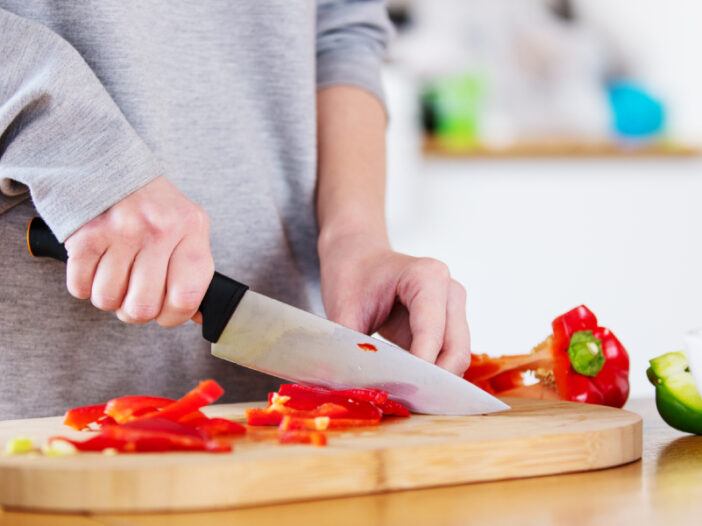
Ever wondered how much a kitchen knife weighs?
Turns out, the average kitchen knife weighs about 700 grams or 1.54 pounds. That’s a lot of weight for something that’s just going to sit in a drawer!
But don’t worry – we’ve got all the info on different types of knives and their weights so you can make an ideal decision before you buy. Keep reading to find out more.
How Much Weight Does a Kitchen Knife Have
Most kitchen knives weigh between 700 grams and 1.54 pounds. This can vary depending on the size and style of the knife.
For example, a regular knife may only weigh 28.35 to 453 grams, while a larger Bowie knife can weigh 680 grams. Some knives, like throwing knives, are designed to be heavier, weighing in at 283 to 454 grams.
Silver knives are usually on the lighter side, weighing in at 65.90 grams on average. Plastic knives are even lighter, typically weighing only 6 grams.
Survival knives tend to be somewhere in the middle, with most knives falling within the 166.41-gram range.
Smaller knives, like a butter knife or a pocket knife, weigh even less, at 56.69 to 255.14 grams and 99.22 grams respectively. Ultimately, the weight of a kitchen knife depends on its size and intended use.
Knife Weight Table
Knife weight varies depending on the type and use. Here we’ve prepared this chart with every knife weight for your convenience.
| Knife Type | Knife Style | Weight(grams) |
| kitchen knife | Regular | 700g |
| Cleaver | 1315g | |
| Butcher | 280g | |
| Pocket Knife | Straight Back | 110g |
| Sheepsfoot | 73g | |
| Drop Point | 99g | |
| Clip Point | 210g | |
| Tanto Point | 250g | |
| Throwing Knife | Handle Heavy | 134g |
| Blade Heavy | 134g | |
| Butter Knife | Regular | 57g – 255g |
| Salmon Knife | Regular | 227g – 340g |
| Paring Knife | Regular | 28g – 113g |
| Silver Knife | Regular | 67g |
| Solid | 51g | |
| Stag | 191g |
What Factors Affect the Weight of a Kitchen Knife
The weight of a kitchen knife is determined by a number of factors, including the type of steel used, the size and shape of the blade, and the handle.
The most important factor, however, is the level of hardness of the steel. A harder steel will be more resistant to wear and tear and will retain its edge longer. However, it will also be more difficult to sharpen.
Thinner steel, on the other hand, will be easier to sharpen but will not hold its edge as well.
Ultimately, the best kitchen knife for you is one that strikes a balance between these two factors. It should be made from a hard enough steel to withstand daily use, but not so hard that it’s difficult to keep sharp.
How to Choose a Kitchen Knife Based on Weight
When choosing a kitchen knife, many people overlook the importance of weight. However, the weight of a knife can have a significant impact on its performance. Heavier knives are typically better at chopping and slicing, while lighter knives are often more maneuverable and easier to control.
So, how do you choose the right weight for your kitchen knife? Here are a few things to keep in mind:
Type of Food
If you’re primarily going to be cutting vegetables or other soft foods, a lighter knife should suffice. However, if you plan on doing a lot of chopping or slicing of tougher meats or bread, you’ll need a heavier knife.
Personal Preferences
If you have smaller hands or are otherwise not as strong, a lighter knife will be easier for you to control. Conversely, if you’re looking for more power behind your cuts, a heavier knife will give you the heft you need.
Balance
A well-balanced knife will feel comfortable in your hand and easy to control, regardless of its weight. When testing out knives, pay attention to how they feel in your hand – if they feel top-heavy or unbalanced, move on to another option.
Quality
It’s important to remember that a heavier knife isn’t necessarily a better knife. The quality of the blade is far more important than its weight. A well-crafted, lightweight knife can outperform a cheaply made heavy knife any day of the week.
Budget
Of course, all things being equal, a more expensive knife is likely to be better quality than a cheaper one. However, there are plenty of great kitchen knives available at all price points. Don’t let cost be the sole determining factor in your decision – choose the knife that feels right in your hand and suits your needs, regardless of price.
Keep these factors in mind, and you’re sure to find the perfect kitchen knife for your needs.
Conclusion
So, now that you know all about kitchen knife weight – how it’s measured and what factors affect it – it’s time to choose the perfect one for your needs.
Remember to consider both the type of knife and its overall weight before making your decision. And be sure to use your new knife safely and effectively by following our tips for the best results.
Hope you are doing great. We are almost ready with the project and will contact you on Friday. However, it will be great for us if you let us know how much you can deliver us in a week. So, we can prepare better plans to work with you. Thanks.
